基于 3,3′,5,5′-(1,3-苯基)-联苯四羧酸配体构筑的具有四重 dmd穿插结构的锌配位聚合物的合成、晶体结构和荧光性质
2014-09-15王记江侯向阳高楼军张美丽任宜霞
王记江 侯向阳 高楼军 张美丽 任宜霞 付 峰
(延安大学化学与化工学院,陕西省化学反应工程重点实验室,延安 716000)
The design and synthesis of novel metal-organic frameworks (MOFs)with entangled systems are of great interest not only because of their potential applications as functional materials but also owing to their intriguing topological structures[1-4].As an important part of entangled systems,interpenetrating nets have provided a longstanding fascination for chemists.Discovery types of topological entanglements have been assembled,such as,polycatenation,polythreading,and polyknotting[5-6].But the topological frameworks containing two kinds of entangled motifs in one compound are still quite rare.
Generally,the structural diversity of such materials are always dependent on many factors,such as metal ion,pH value,template agents,metal-ligand ratio,counteranion,and number of coordination sites provided by organic ligands[7-8].Without a doubt,among these factors,the rational design and reasonable use of the characteristic ligand occupies the capital.The length,rigidly,coordination modes,functional groups or substituent of organic ligands have consequential effect on the final structures of MOFs[9].Especially,the aromatic polycarboxylate ligands can serve as excellent candidates for building highly connected,self-penetrating,or helical coordination frameworks due to their bent backbones and versatile bridging fashions[10-11].
Thus,these considerations inspired us to explore new coordination architectures with 3,3′,5,5′-benzene-1,3-biyl-tetrabenzoic acid(H4BTB)and 4,4′-bipyridine(4,4′-bpy).Herein,wereportonecompound,{[Zn(BTB)0.5(4,4′-bpy)0.5(H2O)2]·0.5H2O}n(1),exhibiting an interesting 4-fold interpenetrated(4·102)2(42·104)-dmd framework.
1 Expermental
1.1 Materials and methods
All reagents and solvents employed were commercially available and used without further purification.The C,H and Nmicroanalyseswerecarried out with a Vario EL Ⅲ elemental analyzer.The FT-IR spectra were recorded from KBr pellets in the range of 4 000~400 cm-1on a Shimadzu Prestige-21 spectrometer.Thermogravimetric analyses (TGA)were performed under nitrogen with a heating rate of 10℃·min-1using a NETZSCH STA 449F3 thermogravimetric analyzer.Fluorescence spectra were performed on a Hitachi F-4500 fluorescence spectrophotometer at room temperature.The PXRD pattern was recorded with a SHIMADZU XRD-7000 diffractometer.
1.2 Syntheses of compound 1
A mixture of H4BTB(0.10 mmol),4,4′-bpy(0.10 mmol),zinc(Ⅱ) acetate dihydrate (0.20 mmol),NaOH(0.40 mmol),and 16 mL H2O was placed in a 25 mL Teflon-lined stainless steel vessel,heated to 160℃for 4 days,followed by slow cooling(a descent rate of 10 ℃·h-1)to room temperature.The colorless block crystals of 1 were obtained.Yield:61% (based on Zn).Anal.Calcd.(%)for C16H14NO6.5Zn (389.65):C,49.31;H,3.62;N,3.59.Found(%):C,48.91;H,3.67;N,3.65.IR(KBr pellet,cm-1):3 367(m),3 195(m),1 617(vs),1 563(s),1 485(s),1 462(m),1 434(vs),1 367(s),1 302(s),1 248(m),1 070(m),817(m),774(s)cm-1.
1.3 Structure determination
Diffraction intensities for the compound 1 was collected at 296(2)K on a Bruker Smart APEXⅡCCD diffractometer equipped with a graphite-monochromated Mo Kα radiation (λ=0.071 073 nm)using the ω-φ scan mode.A semiempirical absorption correction was applied using the SADABSprogram[12].The structure was solved by direct methods and refined by fullmatrix least-squares on F2using the SHELXS 97 and SHELXL 97 programs,respectively[13-14].Non-hydrogen atoms were refined anisotropically and hydrogen atoms were placed in geometrically calculated positions.A total of 7 822 reflections of compound 1 were collected in the range of 2.13°<θ<25.04° (-21≤h≤21,-13≤k≤13,-17≤l≤19)and 2 799 were independent with Rint=0.034 1,of which 2 560 with I>2σ(I)(refinement on F2)were observed and used in the succeeding structure calculation.The final R1=0.035 3,wR2=0.074 0(w=1/[σ2(Fo2)+(0.053 8P)2+1.605 6P],where P=(Fo2+2Fc2)/3),(Δρ)max=793 and(Δρ)min=-496 e·nm-3.Selected bond lengths and bond angles are listed in Table 1.
CCDC:966209.
2 Results and discussion
2.1 Crystal structure of{[Zn(BTB)0.5(4,4′-bpy)0.5(H 2O)2]·0.5H 2O}n(1)
The single-crystal X-ray diffraction analysisreveals that compound 1 crystallizes in the monoclinic system,C2/c space group.The asymmetric unit of 1 consists of one Zn(Ⅱ)ion,a half of BTB4-ligand,a half of 4,4′-bpy ligand,two coordinated and a half of water molecules,shown in Fig.1.Each Zn(Ⅱ)center is penta-coordinated by four O atoms from two different BTB4-ligands and two coordinated water molecules[Zn(1)-O(1)0.194 6(2)nm,Zn(1)-O(3)i0.196 5(2)nm,Zn(1)-O(5)0.219 4(3)nm,and Zn(1)-O(6)0.221 2(3)nm]and one N atoms from one 4,4′-bpy[Zn(1)-N(1)0.202 7(3)nm],resulting in a distorted tetrahedral coordination geometry.The bond angles around Zn(Ⅱ)ion range from 84.15(11)°to 173.23(11)°.

Table 1 Selected bond lengths(nm)and bond angles(°)in complex 1

Fig.1 Coordination environment of Zn(Ⅱ)with 30%probability displacement ellipsoids(left)and the coordination mode of H4BTB ligand(right)in title compound

Fig.2 1D[Zn2(BTB)]n nanotube with the diameter of 0.899 3(9)nm
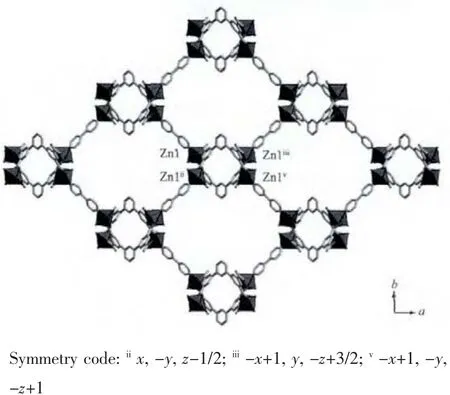
Fig.3 Schematic view of the 1 along the c axis
The H4BTB ligand is completely deprotonated and all of the four carboxylate are adopted μ1-η1∶η0coordination modes (Fig.1),forming an interesting 1D[Zn2(BTB)]nnanotube with the diameter is about 0.8993(9)nm(Fig.2).Furthermore,the4,4′-bpybridged the neighbouring[Zn2(BTB)]nnanotubes,finally given the porous frameworks (Fig.3),with the opening channel of about 2.306 6(9)×2.306 6(9)nm2,and the Zn… Zn distance separated by BTB4-is 1.111 7(7)nm.The 3D networks are further interacted with the adjacent nets with hydrogen bonds[O(5)-H(5)…O(2)vi0.276 8 nm,and O(5)-H(5)B…O(2)vii0.271 1 nm,Symmetry code:vi-x+1/2,-y-1/2,-z,viix,-y,-z+1/2],successfully interpenetrated with each other,assembled into a 4-fold (4·102)2(42·104)-dmd frameworks,in which Zn(Ⅱ)ions and BTB4-ligand act as three-and four-connected nodes,respectively(Fig.4)[15].
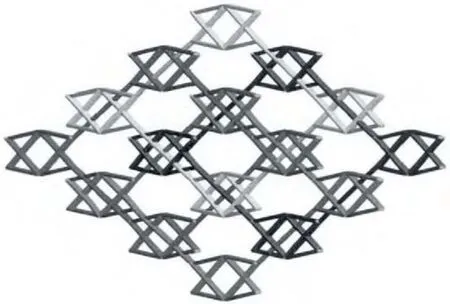
Fig.4 Schematic view of the 4-fold(4·102)2(42·104)-dmd topology of 1
2.2 Infrared spectrum
The FT-IR spectra of compound 1(in KBr)show the bands as follows:3 367(m),3 195(m),1 617(vs),1 563(s),1 485(s),1 462(m),1 434(vs),1 367(s),1 302(s),1 248(m),1 221(m),1 070(m),817(m),774(s)cm-1.For compound 1,the peaks in the range of 1 462~1 617 cm-1corresponding to the asymmetric vibrations (νas)of the carboxylate groups,while the strong strength absorption due to the symmetric vibrations (νs)are span from 1 248 to 1 434 cm-1,respectively (Fig.5).The wavenumber differences are 183,196,183,and 214 cm-1suggests that the carboxylate groups are all in monodentate coordination modes[16].
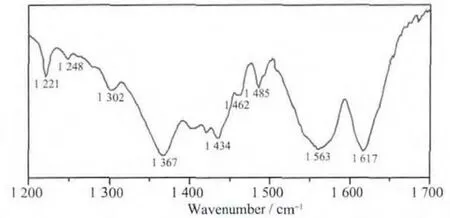
Fig.5 Infrared spectrum of 1
2.3 Thermogravimetric Analysis
In order to investigate the thermal stability of compound 1,thermogravimetric analysis was carried out and the TG curve is depicted in Fig.6.The first weight loss at about 100℃can be attributed to the releaseof water molecules(Obsd.10.7%;Calcd.11.5%).The framework is stable until upon to approximate 460 ℃ and the weight of the residue was 20.7%(Calcd.21.1%)upon approximate 800 ℃.

Fig.6 TG curve for compound 1
2.4 Powder X-ray diffraction analysis
In order to check the phase purity of this complex,the PXRD pattern of title complex was checked at room temperature.As shown in Fig.7,the peak positions of the simulated and experimental PXRD patterns are in agreement with each other,demonstrating the good phase purity of the complexes.The dissimilarities in intensity may be due to the preferred orientation of thecrystallinepowder samples.
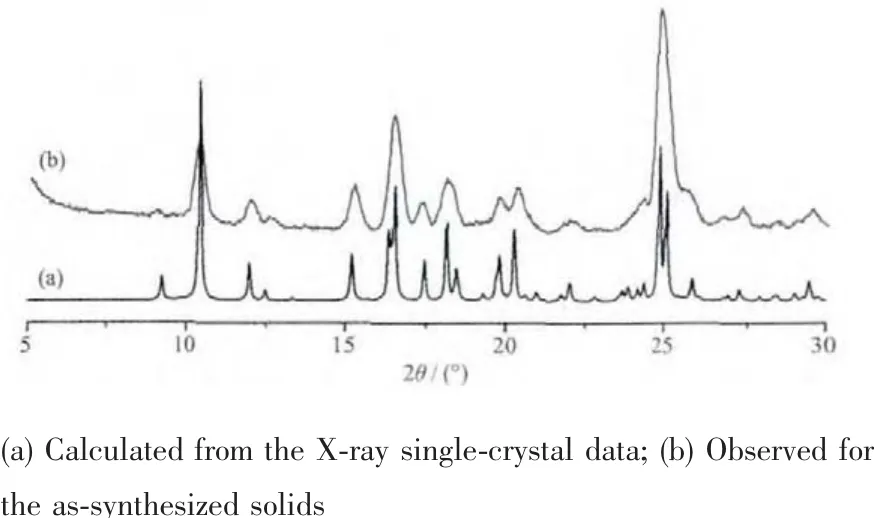
Fig.7 PXRD patterns of 1
2.5 Photoluminescent properties
Many coordination compounds have been extensively studied due to their potential applications as luminescent materials.The fluorescence spectrum of 1 wasexamined in thesolid stateatroomtemperature.The free H4BTB ligand displays luminescence with an emission maximum at 419 nm(λex=347 nm).Luminescence of 1 was investigated showing intense fluorescent emission of 1 at 462 nm (λex=347 nm).As shown in Fig.8,the compound 1 results in a red shift of 43 nm,which can mainly attribute to the intraligand photoluminescence[17-18].The observation indicates that the compound 1 may be one excellent candidate for potential photoactive materials[19].
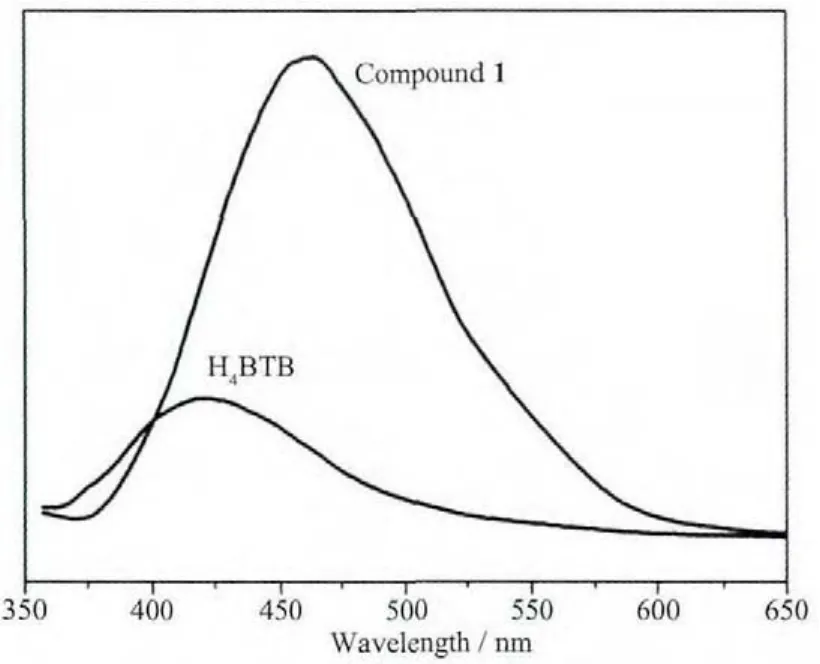
Fig.8 Solid-state emission spectrum of 1 and H4BTB at room temperature
Reference:
[1]Zhang J P,Zhang Y B,Lin J B,et al.Chem.Rev.,2012,112:1001-1033
[2]Zhang X T,Sun D,Li B,et al.Cryst.Growth Des.,2012,12:3845-3848
[3]Evans O,Lin WB.Acc.Chem.Res.,2002,35:511-522
[4]Li D S,Fu F,Zhao J,et al.Dalton Trans,2010,39:11522-11525
[5]Batten S R,Robson R.Angew.Chem.Int.Ed.,1998,37:1460-1494
[6]Du M,Jiang XJ,Zhao XJ.Chem.Commun.,2005:5521-5523
[7]Fan L M,Zhang X T,Li D C,et al.CrystEngComm,2013,15:349-355
[8]ZHANG Xiu-Tang(张修堂),FAN Li-Ming(范黎明),SUN Zhong(孙忠),et al.Chinese J.Inorg.Chem.(无机化学学报),2012,28(9):1809-1816
[9]Zhang X T,Fan L M,Sun Z,et al.Cryst.Growth Des.,2013,13:792-803
[10]Wang J J,Gao L J,Cao P X,et al.J.Coord.Chem.,2012,65:3614-3622
[11]Zhang X T,Fan L M,Sun Z,et al.CrystEngComm,2011,13:5313-5316
[12]Sheldrick G M.SADABS,Program for Empirical Absorption Correction of Area Detector Data,Germany:University of Göttingen,1997.
[13]Sheldrick G M.SHELXS 97,Program for Crystal Structure Solution,Germany:University of Göttingen,1997.
[14]Sheldrick G M.SHELXL 97,Program for Crystal Structure Refinement,Germany:University of Göttingen,1997.
[15]Spek A L.PLATON,A Multipurpose Crystallographic Tool.The Netherlands:Utrecht University,2002.
[16]Fan L M,Zhang X T,Sun Z,et al.Cryst.Growth Des.,2013,13:2462-2475
[17]Cheng X,Liu T,Duan X Y,et al.CrystEngComm.,2011,13:1314-1321
[18]WANG Ji-Jiang(王记江),Hou Xiang-Yang(侯向阳),GAO Lou-Jun(高楼军),et al.Chinese J.Inorg.Chem.(无机化学学报),2014,30(2):1809-1816
[19]Qin J H,Ma L F,Hu Y,et al.CrystEngComm,2012,14(2):379-383
